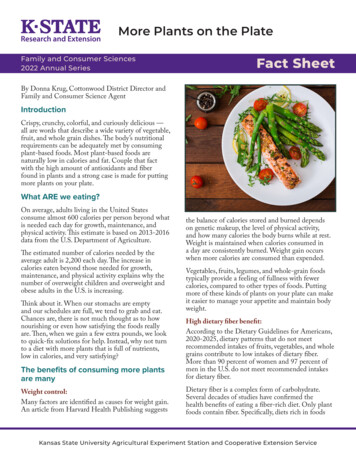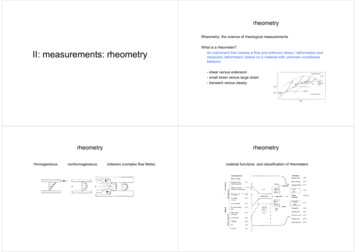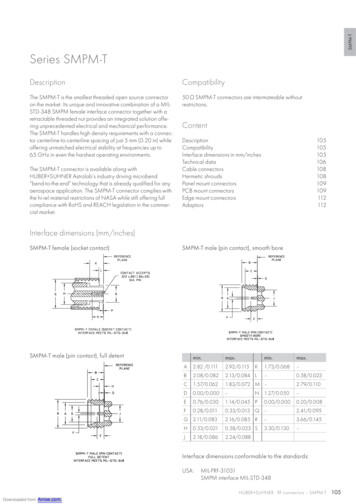
Transcription
More Plants on the PlateFamily and Consumer Sciences2022 Annual SeriesFact SheetBy Donna Krug, Cottonwood District Director andFamily and Consumer Science AgentIntroductionCrispy, crunchy, colorful, and curiously delicious —all are words that describe a wide variety of vegetable,fruit, and whole grain dishes. The body’s nutritionalrequirements can be adequately met by consumingplant-based foods. Most plant-based foods arenaturally low in calories and fat. Couple that factwith the high amount of antioxidants and fiberfound in plants and a strong case is made for puttingmore plants on your plate.What ARE we eating?On average, adults living in the United Statesconsume almost 600 calories per person beyond whatis needed each day for growth, maintenance, andphysical activity. This estimate is based on 2013-2016data from the U.S. Department of Agriculture.The estimated number of calories needed by theaverage adult is 2,200 each day. The increase incalories eaten beyond those needed for growth,maintenance, and physical activity explains why thenumber of overweight children and overweight andobese adults in the U.S. is increasing.Think about it. When our stomachs are emptyand our schedules are full, we tend to grab and eat.Chances are, there is not much thought as to hownourishing or even how satisfying the foods reallyare. Then, when we gain a few extra pounds, we lookto quick-fix solutions for help. Instead, why not turnto a diet with more plants that is full of nutrients,low in calories, and very satisfying?the balance of calories stored and burned dependson genetic makeup, the level of physical activity,and how many calories the body burns while at rest.Weight is maintained when calories consumed ina day are consistently burned. Weight gain occurswhen more calories are consumed than expended.Vegetables, fruits, legumes, and whole-grain foodstypically provide a feeling of fullness with fewercalories, compared to other types of foods. Puttingmore of these kinds of plants on your plate can makeit easier to manage your appetite and maintain bodyweight.The benefits of consuming more plantsare manyHigh dietary fiber benefit:According to the Dietary Guidelines for Americans,2020-2025, dietary patterns that do not meetrecommended intakes of fruits, vegetables, and wholegrains contribute to low intakes of dietary fiber.More than 90 percent of women and 97 percent ofmen in the U.S. do not meet recommended intakesfor dietary fiber.Weight control:Many factors are identified as causes for weight gain.An article from Harvard Health Publishing suggestsDietary fiber is a complex form of carbohydrate.Several decades of studies have confirmed thehealth benefits of eating a fiber-rich diet. Only plantfoods contain fiber. Specifically, diets rich in foodsKansas State University Agricultural Experiment Station and Cooperative Extension Service
“Plant-based diversity is in fact so powerful, solife – and health – changing, that it should be ourGolden Rule of eating.” Dr. Will BulsiewiczFiber Fueledcontaining fiber — such as fruits, vegetables, andwhole grains — may reduce the risk of coronaryheart disease and improve regularity.Chronic disease management:Consuming a diet featuring more plants is goodfor your health — today and tomorrow. Complexcarbohydrates are easy to digest and the antioxidantsthat are present in plants help strengthen yourbody’s immune system. Dr. T. Colin Campbell,long-time Cornell University researcher, found thatmany people with heart disease, diabetes, cancer,and various autoimmune diseases have been ableto alleviate their symptoms by eating more wholegrains, vegetables, fruits, legumes, nuts and seeds andconsuming fewer solid and added fats, added sugars,and refined grains.In his book Fiber Fueled, gastroenterologist Dr. WillBulsiewicz shared this insight about plant-baseddiversity: Evidence indicates that to strengthen thebody’s own defenses against chronic diseases we needto eat the greatest possible variety of vegetable, fruit,and grain dishes.Plant Based Diet Q & AQ: Will I get enough protein if I eat more plants?A: A wide variety of plant-based foods provideprotein (See Table 1). Most people would benefitfrom eating more legumes, whole grains, nuts,and seeds, and eating fewer protein-rich foodscontaining saturated fats or added fats. A commonmisconception about dietary protein is the belief thatlarge amounts of it are needed for good health. TheDRI (Dietary Reference Intake) is 0.36 grams ofprotein per pound of body weight. This amounts to56 grams per day for the average sedentary man and46 grams per day for the average sedentary woman.Q: Won’t eating carbohydrates found in plantfoods make me fat?A: A diet rich in complex carbohydrates suchas fruits, vegetables, and grains, prepared withminimal processing, is not “fattening.” Rather, theoverconsumption of refined carbohydrates, added2 K-State Research and ExtensionTable 1. Plant proteinFoodAmountEdamame – boiledsoybeansLentils, cookedLarge white beans –cookedKidney beans –cookedBlack beans, cookedWalnutsPinto beans, cookedChickpeas(Garbanzo beans)Fava beans – cookedTofu, firmQuinoa, cookedBagelPeanut butterAlmondsSoy milkSunflower seedsCashewsWhole wheat breadBrown rice, cookedSpinach, cookedBroccoli, cooked1 cupAmount ofprotein31.3 g1 cup1 cup17.9 g17.4 g1 cup15.3 g1 cup1 ounce1 cup1 cup15.2 g15.2 g15.4 g14.5 g1 cup4 ounces1 cup1 medium2 tablespoons¼ cup1 cup¼ cup1 ounce2 slices1 cup1 cup1 cup12.9 g11 g9g9g8g8g7g6g5g5g5g5g4gsugars, and fats contributes to excess weight gain.For example, 1 cup of mashed potatoes contains130 calories. Add 1 tablespoon of butter and youhave added 100 calories. But the calories from thebutter do not fill you up, as it does not add bulkto the food. The key to eating well, being full, andbeing completely nourished is to eat foods that arenutrient-dense.Q: My kids hate vegetables, so if we try this, won’t Ibe throwing away a lot of food?A: Do your kids really hate vegetables or have yougiven them a chance to love them? In the curriculumFood is Elementary, by Dr. Antonia Demas, studentsare allowed to first smell the food and then slowlytaste new, whole foods. When kids are involved inselecting and preparing vegetables they are morelikely to eat them. One youngster wrote on his class
evaluation, “I have changed my favorite food fromcandy to broccoli.” Try preparing vegetables in avariety of ways, from raw, to lightly steamed, to stirfried. Children follow adult examples, so make surethey see you enjoying your veggies too.Q: How does an athlete perform when eating moreplants?A: Athletes pay a lot of attention to their nutritionalneeds because they want to get the most out of theirbodies, and they realize what they choose to eatmakes a difference in achieving peak performance.According to Roberta Duyff, RD, author of theAcademy of Nutrition and Dietetics’ Complete Food andNutrition Guide, 5th edition, a vegetarian approach toeating is flexible enough to provide sufficient fuel andnutrition for sports. Campbell’s research concludesthat eating nutrient-dense foods helps generatehealth and a sense of well-being both physicallyand mentally. A registered dietitian nutritionistwho specializes in sports nutrition can provide apersonalized eating plan emphasizing plant-basedfoods that meets the individual needs for their sport.Q: It looks like eating a more plant-based dietmeans cooking from scratch. “I just do not haveenough hours in the day to prepare these dishes!”A: While it is true preparing some grains andlegumes takes some prior planning, most are quiteeasy to prepare. Beans or grain may be soakedovernight and cooked while getting ready for workin the morning. With those items cooked, a plantbased meal can go together in a matter of minutes.Lentils, which are a great source of protein, do notrequire soaking, so can be prepared quickly. Cannedbeans are a good alternative when preparation timeis limited. And don’t forget that many vegetables andvirtually all fruits may be enjoyed raw!Q: I don’t have a large budget for groceries so howcan I afford to buy more grains and fresh produce?A: Pound for pound, purchasing fresh produce andgrains is less expensive than buying meat or packagedconvenience foods and most foods with added fatsand sugars. The health benefits are countless andmay even result in medical cost savings. Another tipfor saving money on groceries is to purchase freshproduce that is in season and locally grown wheneverpossible. Other economical options include frozenand canned vegetables. While people argue that thecost of fresh produce and grain products is high, itdepends on perspective. A cup of coffee or 20-ouncesoda and a pastry can cost 6 or 7. In contrast, acontainer of pre-washed salad greens and a 2-poundpackage of brown rice would cost about the sameamount, but the salad and rice can be consumed byseveral people.Q: Aren’t beans considered an “incomplete” sourceof protein?A: Beans are sometimes referred to as an“incomplete” protein since they do not provide oneof the essential amino acids needed from food forbuilding protein in the body. In actual practice, thisis not a concern. Grains (which lack a differentessential amino acid) provide the amino acid missingfrom dry beans and vice versa. Together, theycomplement each other. Examples of complementaryprotein include peanut butter on whole wheat bread,or beans in a whole grain tortilla. According to theAcademy of Nutrition and Dietetics’ Complete Foodand Nutrition Guide, 5th edition, it is not necessaryto eat complementary sources of protein together atthe same time. Your body makes its own completeproteins if you eat a variety of plant foods —legumes, nuts, seeds, grains, vegetables, and fruits— and enough calories throughout the day. Proteinquality becomes an issue when calories are limited orwhen they come mostly from energy-dense, nutrientpoor food and drink choices.More Plants on the Plate, Fact Sheet 3
Table 2. Transitioning to a healthier dietEat thisBrown riceStone-ground 100%whole-wheat breadRolled oatsA Comprehensive Review of the Benefits of and Barriers to theSwitch to a Plant-Based Diet, MDPI, Feher, Andras; Gazdecki,Michal; Veha, Miklos; Szakaly, Mark; and Szakaly, Zoltan.Abstract published May 2020.Instead ofWhite riceEnriched white breadAmerican Institute for Cancer Research, The New AmericanPlate Cookbook, University of California Press, 2005.Bulsiewicz, Will, MD, MSCI, Fiber Fueled, 2020.Refined grains and sugarycerealsWhole fruitsFruit juiceBaked sweet potatoFrench friesWhole grain flour tortillas White flour tortillasLegumes: lentils, peas and Highly processed meal inbeansa boxAir-popped popcornCookiesCampbell, T. Colin, Ph.D. and Campbell, Thomas, The ChinaStudy, second edition, 2016.Collins, Karen, MS, RD, CDN, American Institute for CancerResearch, Nutrition Wise Newsletter, October 19, 2009.Demas, Antonia, Ph.D., Food is Elementary Curriculum, 2001.https://www.foodstudies.org/Harvard Health Publishing, Why people become overweight,June 24, 2019. -people-become-overweightK-State Research and Extension publications related to foodand aspx?id 24&catId 389&Page 1Where to go from hereMany people simply live to eat. For improved health,now is the time to eat to live. Adopting a moreplant-based diet requires a change in thinking. Asresearch in nutrition has advanced, it has becomeapparent that there is room for improvement withthe typical American plate. Consider includinggenerous portions of vegetables, fruits, whole grainsand lean protein choices at each meal. The options inTable 2 can give you an idea of where to start. Thisgradual transition to a plate with less high-fat andmore nutrient-dense choices seems to be central inmanaging many of the health problems that concernus most.Krug, Donna. 2018. Healthy Cooking Styles, Fact Sheet.K-State Research and Extension publication MF3350. onal Institute of Health website with Dietary ReferenceIntakes. ference Intakes.aspxO’Connor, Nancy, Rolling Prairie Cookbook, 1998. Publishedby: Spring Wheat Nutrition Education Services, Lawrence, KS66046.U.S. Department of Agriculture and U.S. Departmentof Health and Human Services. Dietary Guidelines forAmericans, 2020-2025 9th Edition. December 2020. Availableat DietaryGuidelines.govMyPlate Kitchen. Visit MyPlate Kitchen, a USDA resourcethat gives the user the chance to save recipes into their owncookbook. Register for a free account at https://www.myplate.gov/myplate-kitchen/recipes. Then search recipes for ones youwant to use for your family. Click the plus sign on the recipe toadd it to your cookbook.ResourcesAcademy of Nutrition and Dietetics Complete Food andNutrition Guide, 5th edition. Book by Duyff, Roberta Larson,MS. RD, FADA, CFCS, 2017, pages 52-59, 614, 775.AuthorDonna Krug, District Director and Family and Consumer Science Agent, K-State Research and Extension – Cottonwood DistrictReviewed by:Sandy Procter, Ph.D., RD/LD, Assistant Professor and State Extension Nutrition Specialist,Department of Food, Nutrition, Dietetics and Health, Kansas State UniversityLori Wuellner, Nutrition, Food Safety and Health Agent, K-State Research and Extension – Wyandotte CountyKansas State University Agricultural Experiment Station andCooperative Extension ServicePublications from Kansas State University are available at:www.bookstore.ksre.ksu.eduDate shown is that of publication or last revision. Contents of thispublication may be freely reproduced for educational purposes. Allother rights reserved. In each case, credit Donna Krug, More Plants onthe Plate, Fact Sheet, Kansas State University, July 2021.K-State Research and Extension is an equal opportunity provider andemployer. Issued in furtherance of Cooperative Extension Work, Actsof May 8 and June 30, 1914, in cooperation with the U.S. Departmentof Agriculture, Director of K-State Research and Extension, KansasState University, County Extension Councils, Extension Districts.MF2977 rev.July 2021
More Plants on the PlateLeader’s GuideFamily and Consumer Sciences2022 Annual SeriesBy Donna Krug, Cottonwood Extension DistrictDirector and Family & Consumer Science AgentIntroductionResearch supports eating a variety of plant-basedfoods to promote health, but most people do not getenough of these nutrient-dense foods. Most plantbased foods are naturally low in calories and fat andhave high amounts of antioxidants and other healthfulphytochemicals, as well as fiber. This lesson is designedto help participants improve health by finding ways toput more plants on the plate.Educational GoalsAs a result of participating in this educational program,the learner will be able to: Describe several health benefits associated witheating a more plant-based diet. Understand how adding more whole grains,vegetables, legumes, and fruits to their diet mayhelp reduce consumption of solid fats and addedsugars.Prepare one or more plant-based recipe(s) toshare with participants. Purchase samples of whole grains, legumes, andbeans to show the audience. Become familiar with nutrition facts labeling onboth canned and dry beans and legumes. In the weeks leading up to teaching the lesson,purchase and prepare several vegetables that youhave not eaten before. Try different methods ofpreparation and see which your family likes best.Share this information with participants. Visit the K-State Research and Extensionwebsite at www.ksre.ksu.edu/humannutritionand navigate several links. Become familiar withinformation available on this site. If time allows,look at other state Extension sites. Another goodsite with several excellent programs may be foundat: http://lancaster.unl.edu/food Identify a number of plant foods that cancontribute protein to the diet. Increase knowledge about cooking techniques forpreparing whole grains, beans and legumes, andfruits and vegetables. Discover how eating a diet rich in plant-basedfoods can be satisfying and delicious.Intended Audiences Adult groups of any age, community groups,WIC parents, young parent groups, FamilyCommunity Education groups. Before the lesson, consider these suggestions: Read the More Plants on the Plate leader’s guide(MF2978) and fact sheet (MF2977) and recipeguide. Familiarize yourself with terms and chartsin them.Presenting the lesson:There are notable health benefits when a personincreases their intake of whole grains, vegetables,and fruits, and limits the amount of fat and highlyprocessed foods in their daily menu plan. Plant-basedKansas State University Agricultural Experiment Station and Cooperative Extension Service
foods are naturally low in calories and high in fiber,which can help a person maintain a healthy weightand digestive system. Since a healthy digestive systemtranslates to a healthy immune system, overall healthbenefits are noticeable.Consider asking the following questions prior toteaching the lesson and then revisit them at theconclusion.TF1) Dark green vegetables providemany nutrients, including calcium.2) Beans must be eaten with rice inthe same meal to make the protein in them complete.3) Quinoa is a fruit grown in theMiddle East.4) Eating too many complexcarbohydrates is a reason for the rise of obesity rates inour country.5) Brown rice, millet, barley, popcorn,and oatmeal are all examples of whole grains.6) A juicy steak has more fiber than aserving of popcorn.protein.7) Nuts and seeds are good sources of8) Lentils must be soaked beforecooking for best results.9) Most plant-based foods arenaturally low in calories and fat.10) A nutrient-dense food has lots ofvitamins and minerals in relationship to the number ofcalories it provides.Since many people may have questions about eating amore plant-based diet, review the Q and A section in theparticipant’s fact sheet. Reviewing these will help reinforcethe answers to the questions above.The need for proteinA common misconception about dietary protein isthe belief that large amounts of it are needed forgood health. The DRI (Dietary Reference Intake) is0.36 grams of protein per pound of body weight. Thisamounts to: 63 grams per day for the 175-poundsedentary man and 46 grams per day for the130-pound sedentary woman.2 K-State Research and ExtensionAffordability of eating a healthy dietMany people complain about the high cost of freshproduce and grain products. Common arguments are:“I can’t afford to eat lots of fruits and vegetables,” or“Healthy foods are expensive.” This is not always thecase, and there are many tips shoppers can use to savemoney. A cup of coffee or one 20-ounce soda and apastry can cost up to 6 or 7. In contrast, a containerof pre-washed salad greens and a 2-pound package ofbrown rice would cost around the same amount. Theseitems can be consumed over several days by multiplepeople. Doing whatever is in your power to preventchronic diseases by making healthy food choices cansave money in the long run.Encourage your audience to: Choose nutrient-dense foodsat every meal and at snack time. Foods that providesubstantial amounts of vitamins and minerals andrelatively fewer calories are nutrient-dense. Nutritionexperts agree that most Americans are overweight yetoften undernourished; most people consume too manyfoods that are high in calories but low in nutrient value.As the nation turns its attention to reducing calories,getting the most nutrients from those remainingcalories becomes essential.So, if you crave a serving of French fries once in awhile, what should you do? Think about what you arereally craving. Perhaps it is the texture or the saltinessof the fries. Try roasting thin wedges of a sweet potato,tossed with a little extra virgin olive oil, and spiced upwith a little garlic powder or herb seasoning. All youneed are the right ingredients, a few trusted recipes,and a desire to eat healthful food. (See recipe handoutthat accompanies this lesson.)If time allows, introduce the audience to MyPlateKitchen, a USDA resource that gives the user thechance to save recipes into their own cookbook.Register for a free account at https://www.myplate.gov/myplate-kitchen/recipes. Then search recipes for ones youwant to use for your family. Click the plus sign on therecipe to add it to your cookbook.ConclusionMany people simply live to eat. For improved health,now is the time to eat to live. Adopting a more plantbased diet requires a change in thinking. As researchin nutrition has advanced, it has become apparentthat there is room for improvement with the typicalAmerican plate. Consider including generous portionsof vegetables, fruits, whole grains and lean proteinchoices at each meal. This gradual transition to a platewith less high-fat and more nutrient-dense choicesseems to be central in managing many of the healthproblems that concern people most.
Demas, Antonia, Ph.D., Food is Elementary Curriculum, 2001.https://www.foodstudies.org/Transitioning to a healthier dietEat thisBrown riceStone-ground 100%whole-wheat breadRolled oatsInstead ofWhite riceEnriched white breadHarvard Health Publishing, Why people become overweight,June 24, 2019. -people-become-overweightK-State Research and Extension publications related to foodand aspx?id 24&catId 389&Page 1Refined grains and sugarycerealsWhole fruitsFruit juiceBaked sweet potatoFrench friesWhole grain flour tortillas White flour tortillasLegumes: lentils, peas and Highly processed meal inbeansa boxAir-popped popcornCookiesKrug, Donna. 2018. Healthy Cooking Styles, Fact Sheet.K-State Research and Extension publication MF3350. onal Institute of Health website with Dietary ReferenceIntakes. ference Intakes.aspxO’Connor, Nancy, Rolling Prairie Cookbook, 1998. Publishedby: Spring Wheat Nutrition Education Services, Lawrence, KS66046.Resources:U.S. Department of Agriculture and U.S. Departmentof Health and Human Services. Dietary Guidelines forAmericans, 2020-2025 9th Edition. December 2020. Availableat DietaryGuidelines.govAcademy of Nutrition and Dietetics Complete Food andNutrition Guide, 5th edition. Book by Duyff, Roberta Larson,MS. RD, FADA, CFCS, 2017, pages 52-59, 614, 775.A Comprehensive Review of the Benefits of and Barriers to theSwitch to a Plant-Based Diet, MDPI, Feher, Andras; Gazdecki,Michal; Veha, Miklos; Szakaly, Mark; and Szakaly, Zoltan.Abstract published May 2020.American Institute for Cancer Research, The New AmericanPlate Cookbook, University of California Press, 2005.MyPlate Kitchen. Visit MyPlate Kitchen, a USDA resourcethat gives the user the chance to save recipes into their owncookbook. Register for a free account at https://www.myplate.gov/myplate-kitchen/recipes. Then search recipes for ones youwant to use for your family. Click the plus sign on the recipe toadd it to your cookbook.Answers to the test:Bulsiewicz, Will, MD, MSCI, Fiber Fueled, 2020.1) T2) F3) F4) F5) TCampbell, T. Colin, Ph.D. and Campbell, Thomas, The ChinaStudy, second edition, 2016.Collins, Karen, MS, RD, CDN, American Institute for CancerResearch, Nutrition Wise Newsletter, October 19, 2009.6) F7) T8) F9) T10) TFind contact information for your local extension office maps.htmlAuthorDonna Krug, District Director and Family and Consumer Science Agent, K-State Research and Extension – Cottonwood DistrictReviewed by:Sandy Procter, Ph.D., RD/LD, Assistant Professor and State Extension Nutrition Specialist,Department of Food, Nutrition, Dietetics and Health, Kansas State UniversityLori Wuellner, Nutrition, Food Safety and Health Agent, K-State Research and Extension – Wyandotte CountyKansas State University Agricultural Experiment Station andCooperative Extension ServicePublications from Kansas State University are available at:www.bookstore.ksre.ksu.eduDate shown is that of publication or last revision. Contents of thispublication may be freely reproduced for educational purposes. Allother rights reserved. In each case, credit Donna Krug, More Plants onthe Plate, Leader’s Guide, Kansas State University, July 2021.K-State Research and Extension is an equal opportunity provider andemployer. Issued in furtherance of Cooperative Extension Work, Actsof May 8 and June 30, 1914, in cooperation with the U.S. Departmentof Agriculture, Director of K-State Research and Extension, KansasState University, County Extension Councils, Extension Districts.MF2978 rev.July 2021More Plants on the Plate, Leader’s Guide 3
Evaluation: More Plants on the PlateThank you for participating in our program. To help us improve this program, we would like to gather your responses to thequestions below. Your participation is voluntary. This information will only be used for evaluation purposes, and you will not beidentified in any way by the information you provide.For each of the items below, please indicate your level of agreement with each statement.After participating in this program, I gained knowledge about:StronglyAgreeAgreeNeither Agreenor DisagreeDisagreeStronglyDisagree1. The health benefits of eating a more plant-based diet.2. Good sources of protein that come from plants.3. Choosing nutrient-dense foods that do not have addedsolid fat and sugar.4. Cooking techniques to create delicious plant-basedrecipes.5. As a result of this program, I have also learned:As a result of this program, I will :6. Add more plant-based options to my daily menus.7. Choose to eat a nutrient-dense food at every meal orsnack.8. Prepare food using a healthy cooking method that is newto me.9. Share this information with someone else.10. If you agree above, please describe the actions or changes planned:11. I am an adult: 18-29 Years 30-39 Years 40-49 YearsPrefer not to respond12. Gender: FemaleMale50-59 Years 60-69 Years 70 YearsPrefer not to say13. What is your race/family roots? (Check all that apply):American Indian, Native American AsianPrefer not to answerAfrican American, African, BlackNative Hawaiian, Pacific IslanderOther14. Check the ethnicity that you identify with:Hispanic/ LatinoNon-Hispanic/ Non-LatinoPrefer not to respond15. M arital Status (please check only one): MarriedWidowed Prefer not to respond4 K-State Research and ExtensionDivorcedSeparatedSingle/cohabitating
Consuming a diet featuring more plants is good for your health — today and tomorrow. Complex carbohydrates are easy to digest and the antioxidants that are present in plants help strengthen your body’s immune system. Dr. T. Colin Campbell, long-time Cornell University researcher, fou










